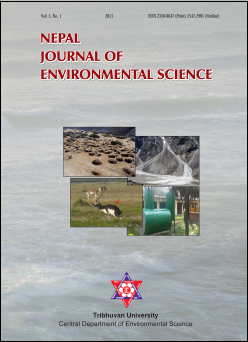Periglacial environment in Nepal Himalaya: Present contexts and future prospects
DOI:
https://doi.org/10.3126/njes.v5i0.22713Keywords:
Mountain, permafrost, rock glacier, high altitude, HimalayaAbstract
Periglacial environment in the Nepal Himalaya (80°04’ to 88°12’ E longitude and 26°22’ to 30°27’ N latitude) is a research field that has received a little scientific attention although the first reported periglacial research was in 1958. After the first periglacial research, only 22 studies are reported in Nepal (area: 147,181 km2), most of which is carried out by researchers outside the country. Studies mainly focus on periglacial landforms and determining the lower limit of the mountain permafrost. The mean lower limit of permafrost (LLP) and the size of rock glaciers indicate a decreasing trend of the permafrost limit from the eastern (5239 m a.s.l.) to the western part of Nepal (4513 m a.s.l.). The rate of change in the LLP in response to climate change in Nepal Himalaya is 1.3–2.6 m/yr. Model on the scenario of permafrost change based on the IPCC climate scenarios shows that the LLP would rise by 188 m between 2009 and 2039 with the rise in temperature. The periglacial landforms, like vegetated patterned ground (earth hummocks, turf banked terraces), sorted polygons, sorted stripes, solifluction lobes, striated ground, and rock glaciers are reported from the Nepal Himalaya. The spatial and temporal coverage of periglacial research in Nepal Himalaya is very low. The arena of periglacial researches, like permafrost distribution modelling, periglacial hazards, periglacial ecology, relationships between permafrost and rangeland, and implication on mountain livelihood, global warming and periglacial change are the potential areas of research in the coming days.
Downloads
Downloads
Published
How to Cite
Issue
Section
License
This license enables reusers to distribute, remix, adapt, and build upon the material in any medium or format for noncommercial purposes only, and only so long as attribution is given to the creator.

